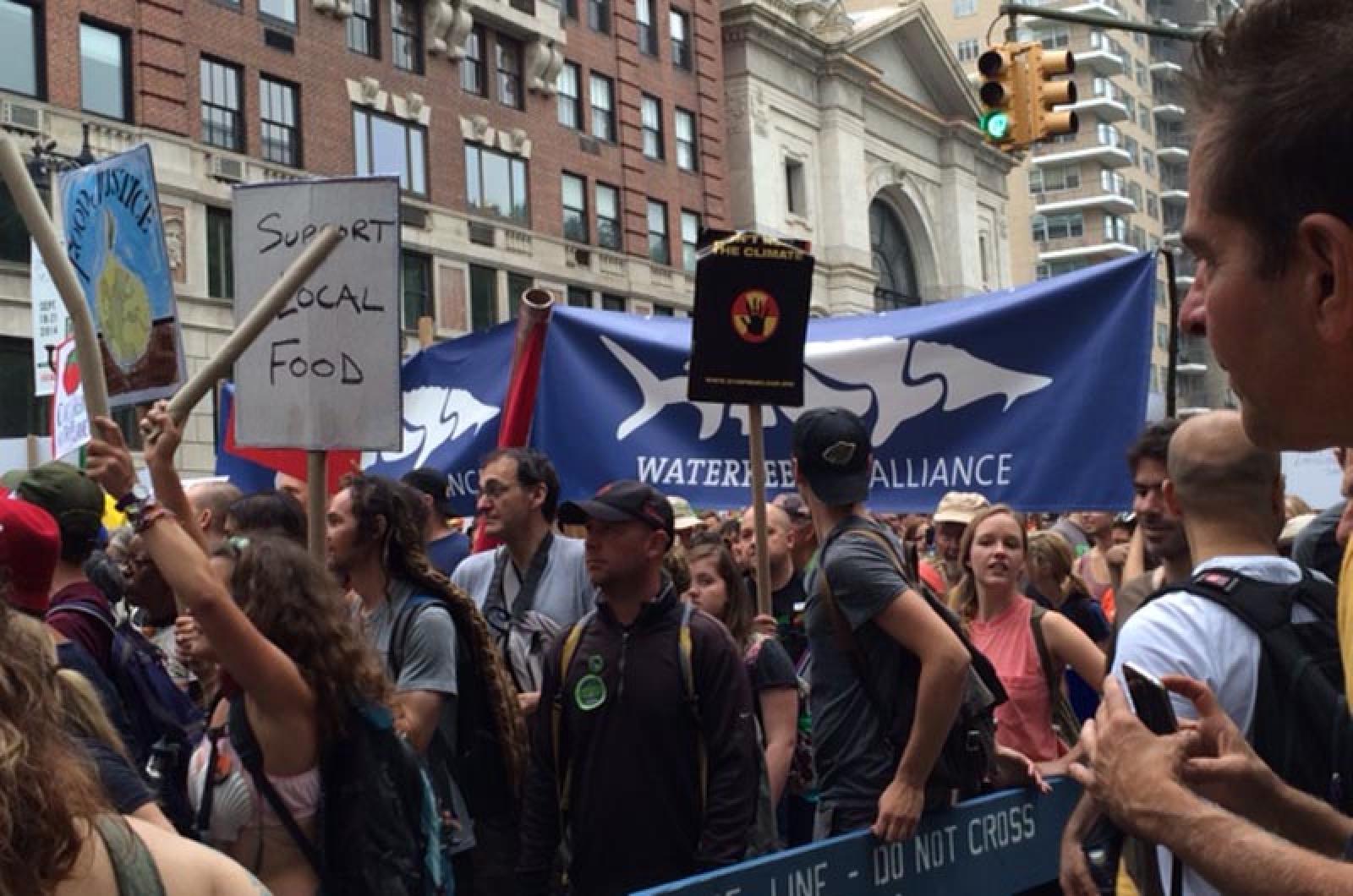We were expecting over 100,000 demonstrators. As the day progressed, the numbers kept climbing. The last estimate is that 400,000 people joined the People’s Climate March on that beautiful Sunday, Sept. 21, in New York city, and all because of our shared concern about climate change.
The march started at Central Park South with the indigenous people of the world leading the way. I was nearly 20 blocks behind them, on Central Park West and 77th street, and in good company. The Natural Resource Defense Council, Waterkeepers Alliance, World Wildlife Fund, Sierra Club and other national and local organizations were assembled in set locations, providing signs, T-shirts, bandannas, pins and fact sheets. While we waited for the march to begin, a number of speakers rallied the growing crowd for close to two hours, which helped to focus and unite us.
Live folk and world music was a backdrop to the broadcasts. We heard a First Nation Canadian talk about the terrible impact of tar sands extraction on their people, land, rivers and wildlife. A woman from West Virginia spoke of growing up in coal country, losing loved ones to black lung and mining accidents, and witnessing the unfathomable scale and destruction of mountaintop removal. Environmental leaders also took to the podium — we could not see them, but we heard them:
• “We have had greater greenhouse gas emissions than any time in history in 2013.”
• “Yes, the U.S. may have stepped up regulations so that we are burning less coal here, but the U.S. is exporting coal to other countries at a rate that explains why carbon emissions have soared during the Obama administration.”
• “China has nearly surpassed Germany, the leading western nation in renewable energy production; 20 per cent of the energy produced in China is now solar.”
Then we heard how to “hold the line” with four political strategies:
• No warming beyond two degrees Celsius (3.6F.).
• De-carbonization (get carbon out of the energy system).
• Pathways. Every country must show the path to de-carbonization.
• Do not support any politicians who refuse to put forward pathways to de-carbonization.
All of this is aimed at the upcoming Climate Talks in Paris next December 2015. The speaker was emphatic: “We are putting the politicians on notice. We outnumber Exxon Mobil. We outvote Exxon Mobil. And we outpower Exxon Mobil.”
Then the march began. Signs were raised, floats began to drift above us, a river of people, with me ebbing in and out of the flow. I tried to document as much as I could with my iPhone.
I saw a man dressed as an angel — his wings, nearly as long as he was tall, were covered with thousands of tiny white feathers. I saw a boy in a polar bear suit. There were families with strollers, inner-city kids and Girl Scouts, old hippies and young lawyers, college professors and students of all ages and so many comfortable shoes. I took pictures of peoples feet, faces, banners and totems. I made friends and contacts. I talked to the executive director of China’s World Wildlife Fund. I was blessed by a native elder from a mountain tribe in Peru, her small pot of herbs smoldering with smoke.
Political activists handed out flyers with hash tags and websites. They shared their views on Occupy, socialism and corporate tyranny. A few invited me to Flood Wall Street, which was happening the next day. The plan was to shut down the New York Stock Exchange to symbolize shutting down capitalism in order to end the climate crisis. Divest from Fossil Fuels was a consistent theme on signs and in songs. I did get to Wall street on Monday morning for an hour. It was very powerful. But on Sunday marching down Central Park West, I was part of this gentler flood that also had great force.
That next day, in Battery Park with hundreds of activists dressed mostly in blue to represent the flood — artists, environmentalists, socialists, families and workers, cops on walkie-talkies and lawyers in neon green hats (there to protect the civil rights of the demonstrators) — we heard that the count for Sunday’s march was up to 400,000. I could not wrap my mind around this. How could so many people be organized so effectively? Imagine the year-round population of Martha’s Vineyard — 15,000 people — gathering and then marching from the Edgartown Lighthouse to the Steamship Authority in Vineyard Haven via State Beach in Oak Bluffs. Then imagine our summer population — 115,000 people — marching along Sengekontaket Pond in August.
Thousands of people all agreed on something fundamental. We were able to organize because of a fairly new infrastructure which shows that the world is flat. Laptops, Androids and iPhones — our flat screens — allow us to travel great distances and connect to ideas and movements and people. In a sense, we hold the future of our precious democracy in the palm of our hands. The internet is not only the information highway; it is also the road to a civil society. I knew where to go that auspicious day in New York city — and when, because I am connected. I have access to information. And because I care. Clearly, I am not alone.
Megan Ottens-Sargent lives in Aquinnah.





Comments (1)
Comments
Comment policy »